M&A Report

En Bref
- M&A in the telecommunications industry declined by nearly 40% in value over the first three quarters of 2022 following strong growth in 2021.
- Fully 85% of deal value involved either in-country consolidations or infrastructure deals, with the latter fetching multiples as high as 24.7 times.
- The soaring cost of debt in 2022 further strained leveraged investments, creating the need for consolidation and divestments.
- We expect strong deal flows in 2023 for consolidation, digital infrastructure, delayering business units, and private investment.
This article is part of Bain's 2023 M&A Report.
Just as the economic challenges caused by the Covid-19 pandemic abated, new global crises surfaced in the form of war, geopolitical realignments, inflation, and mounting energy concerns. The resulting macroeconomic uncertainty and rising cost of debt was reflected in telecom M&A activity, with deal value declining by about 40% and volume by about 15% during the first three quarters of 2022 following strong growth for both in 2021. As a sign of industry strength, however, deal multiples remained high across many subsectors.
M&A activity in 2022 continued to reflect five longer-term underlying industry trends that had been building over the previous years (see Figures 1a and 1b).
Two deal types—scale deals and infrastructure divestments—comprise about two-thirds of telecommunications deal value
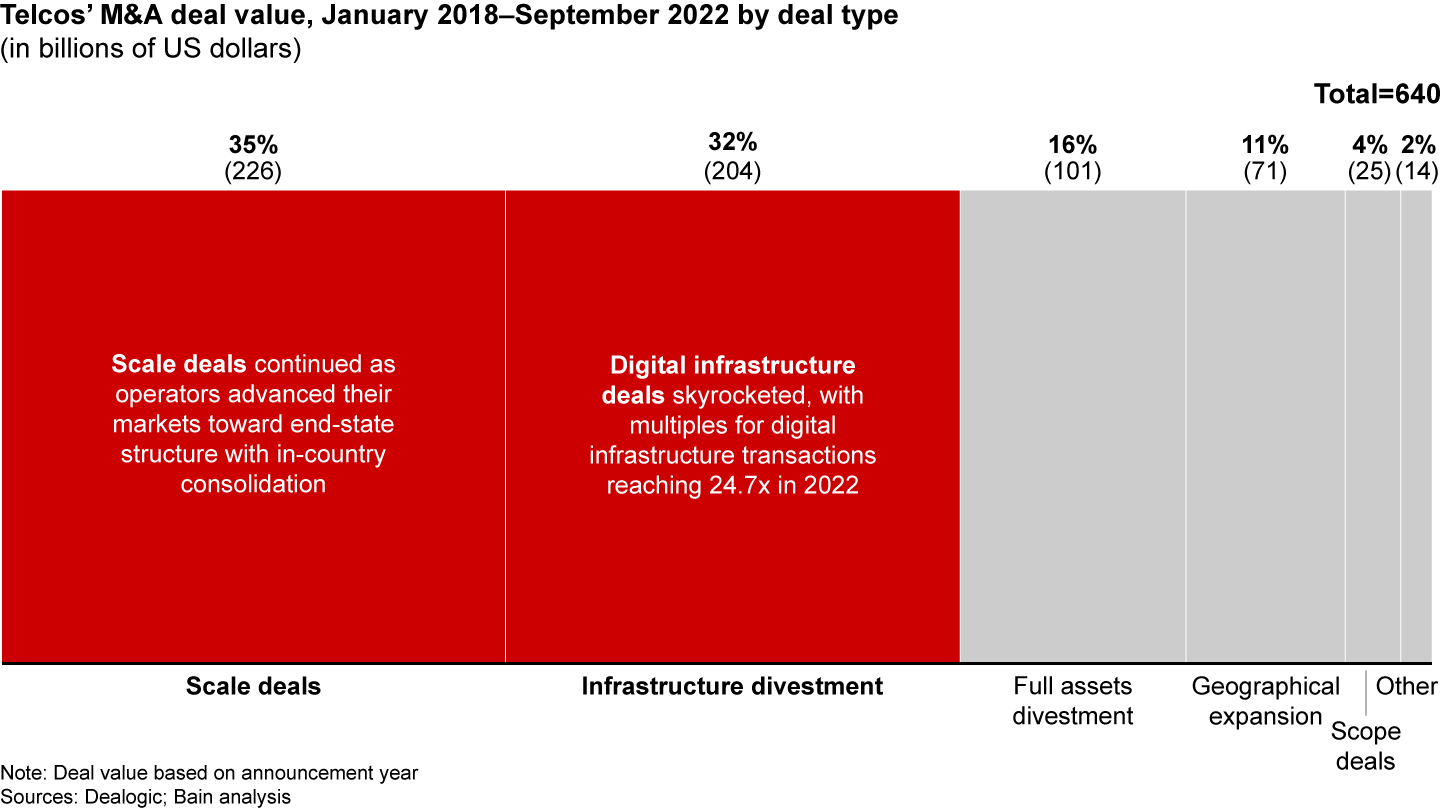
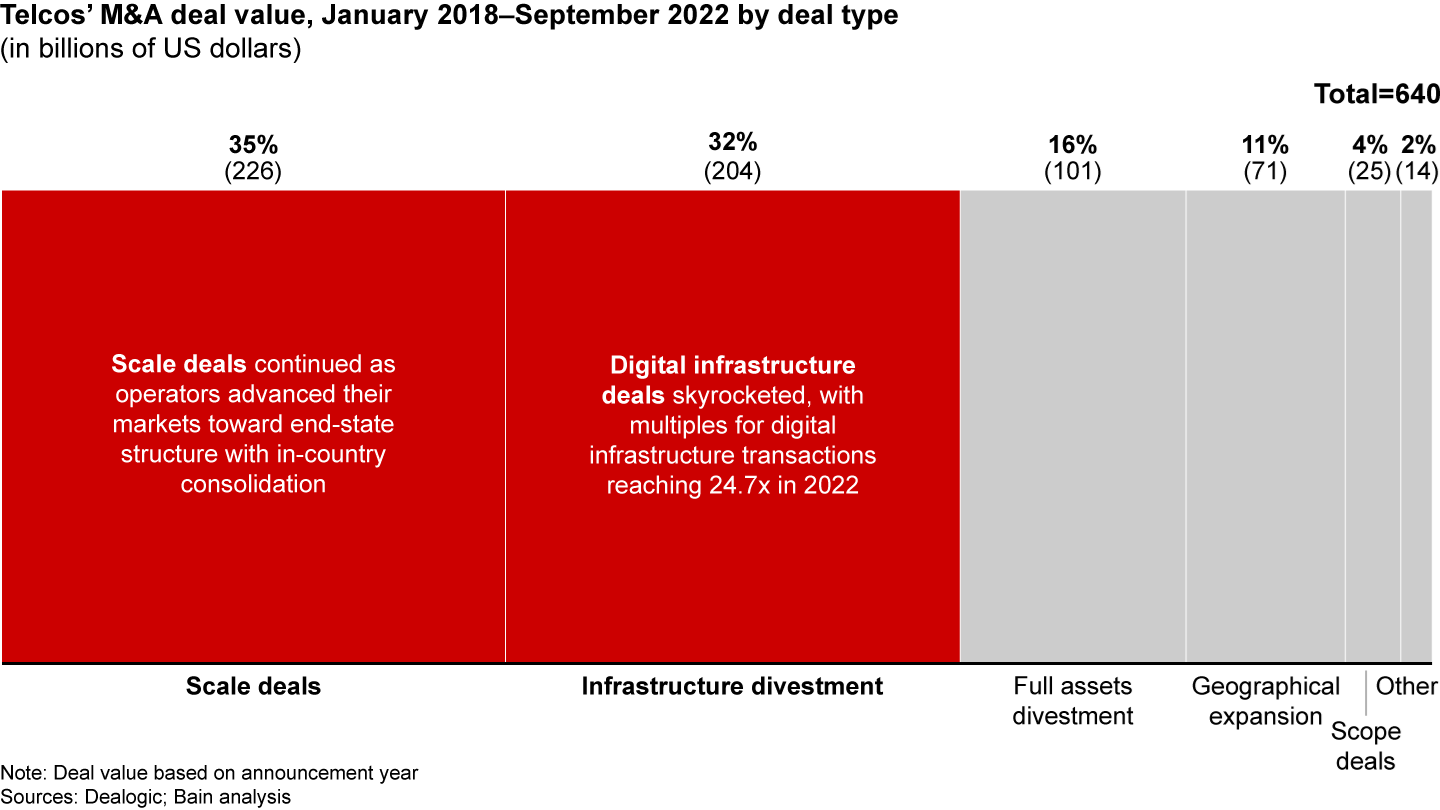
And three other trends continued to cut across deal types
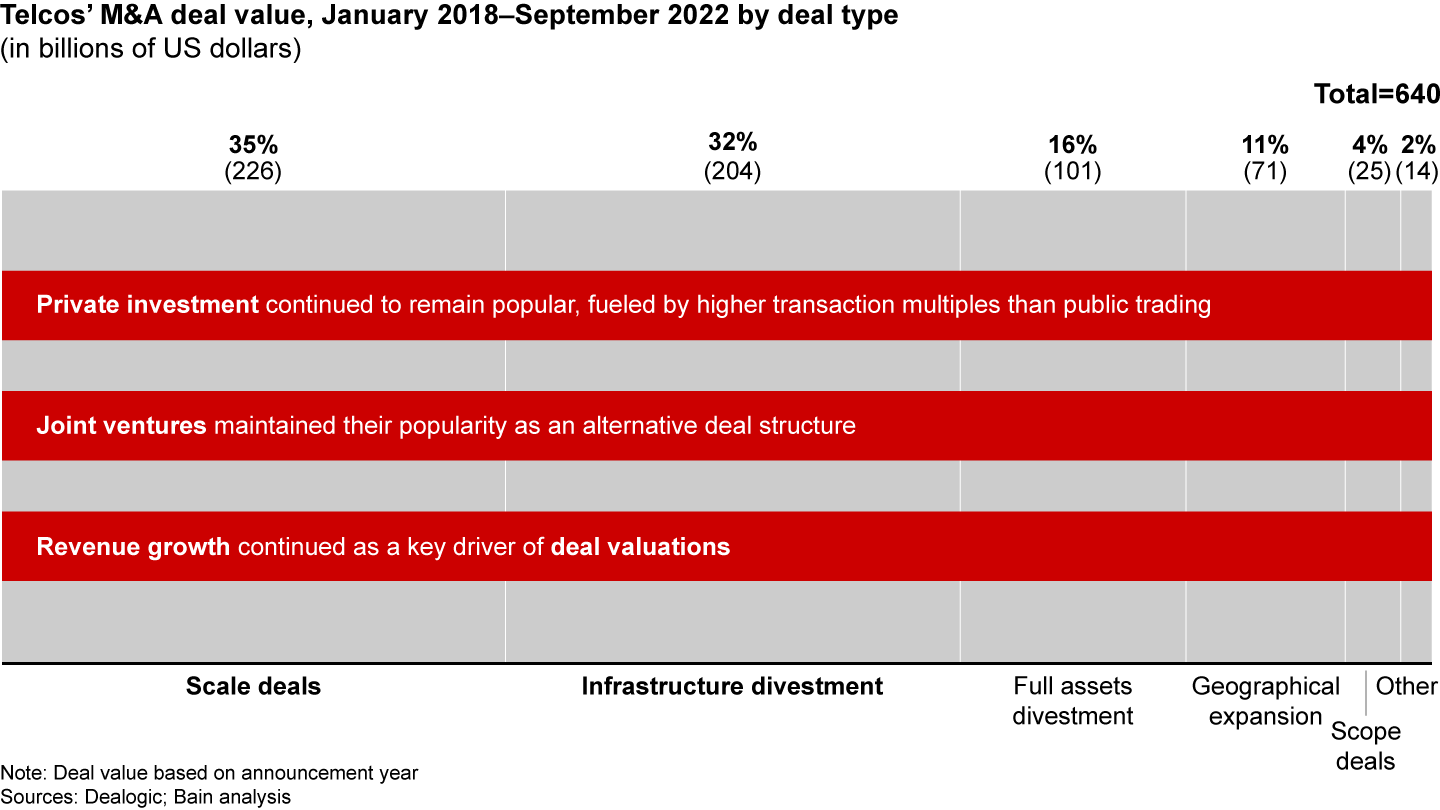
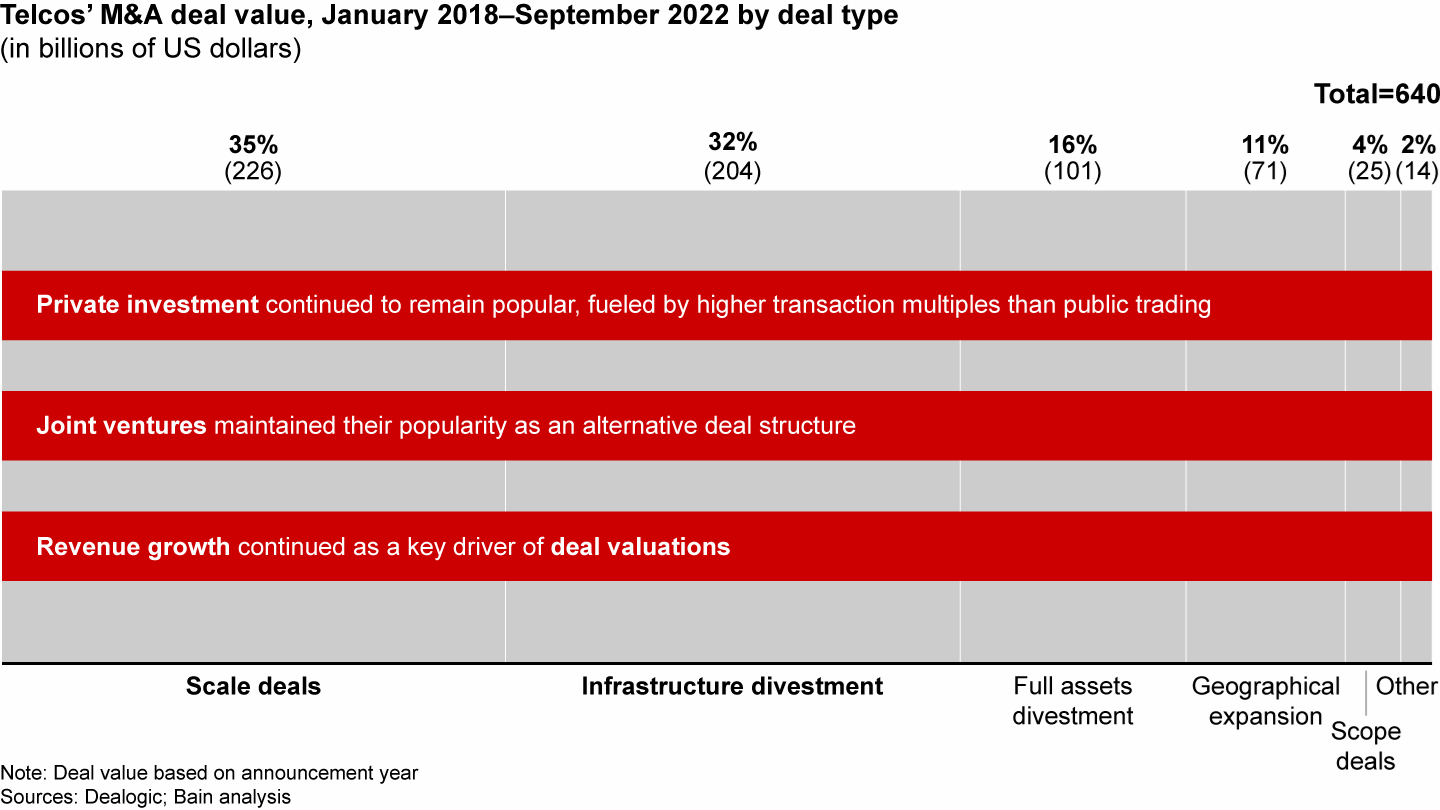
Scale deals for in-country consolidation continued as operators advanced their markets toward that end state before competitors beat them to it. For example, consider Axiata and Axiata XL’s $1.128 million deal for Link Net and Quebecor’s pending purchase of Freedom Mobile for $2.2 billion.
Digital infrastructure deals, particularly tower and fiber assets, skyrocketed, with multiples for digital infrastructure transactions reaching 24.7 times in 2022, up from an average of 17 times in 2021. And 2022 had some notable infrastructure deals, such as the one in which Brookfield Asset Management and US private equity group DigitalBridge bought control of Deutsche Telekom’s GD Towers for $10.7 billion as well as the $2.68 billion deal in which AustralianSuper and Singtel-owned Australia Tower Network acquired Axicom, an Australian provider of telecommunications tower infrastructure.

Telecom M&A: Here Are the Latest Deal Trends Worldwide
Telecommunications M&A deal value nearly tripled in the first half of the year, as some telcos increase scale and others divest infrastructure.
Private investments continued in telcos across all deal types. Fueled by higher transaction multiples for private transactions than public trading, the total value of their investments in the industry still reached $32 billion in 2022, yet down from $35 billion in 2021. Consider CVC Capital Partners’ proposal for 49% of Telecom Italia’s new enterprise services unit in a deal that values the company at $6.3 billion or the Carlyle Group’s $1 billion partnership with Tillman Global Holdings to ramp up Tillman Infrastructure, its independent cell tower company.
Joint ventures maintained their popularity as an alternative deal structure in large digital infrastructure deals such as Indosat Ooredoo Hutchison’s $224 million joint venture with PT Aplikanusa Lintasarta and Big Data Exchange to establish an enterprise and hyperscale data center business in Indonesia, as well as in market consolidations such as MásMóvil and Orange Spain’s $19 billion deal to combine businesses in that country.
Joint ventures maintained their popularity in large digital infrastructure deals.
Revenue growth continued as a key driver of deal valuations in 2022. In scale deals, companies sought revenue synergies by cross-selling to different products’ customer bases while most digital infrastructure deals were aimed at generating revenue growth from higher asset utilization.
What’s changing and what lies ahead?
The macroeconomic uncertainties and various crises of 2022 led some governments to respond with rescue and stimulus packages such as the European Recovery Fund—and some of the benefits will flow to digital infrastructure investments. Additionally, regulators in places as diverse as Thailand and Chile showed a favorable stance toward industry consolidation.
While the impact started being felt only during the last half of 2022, these and other factors are likely to affect deal activity in 2023 and beyond in multiple ways.
Some challenger telcos will find it necessary to consolidate.
Scale deals will remain robust in the still fragmented and less strictly regulated markets of Latin America, Africa, and Asia, with more consolidation of traditional mobile-mobile and fixed-mobile assets. In maturing fiber markets, alternative networks (or “altnets”) will be hurt by the high cost of debt (see Figure 2). Some will need to find an exit strategy soon as they fall behind on their investment plans, fail to capitalize on their builds, or miss milestones critical for their debt-financing banks. Meanwhile, some challenger telcos (the No. 3 or No. 4 players in their markets) that had benefited from inexpensive capital will hit a wall as debt comes up for refinancing. They, too, will find it necessary to consolidate.
The cost of debt soared by about 3.5 percentage points between September 2021 and September 2022
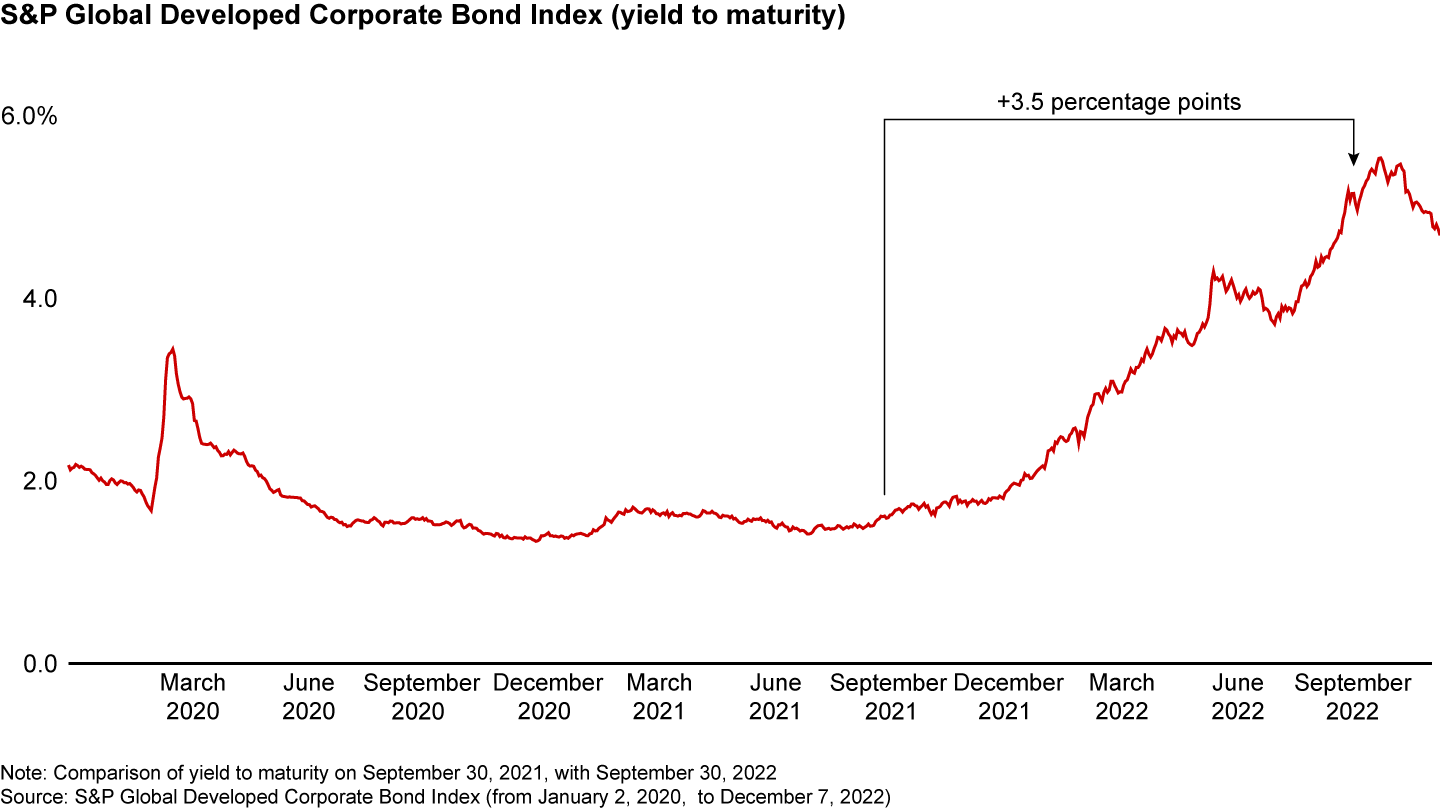
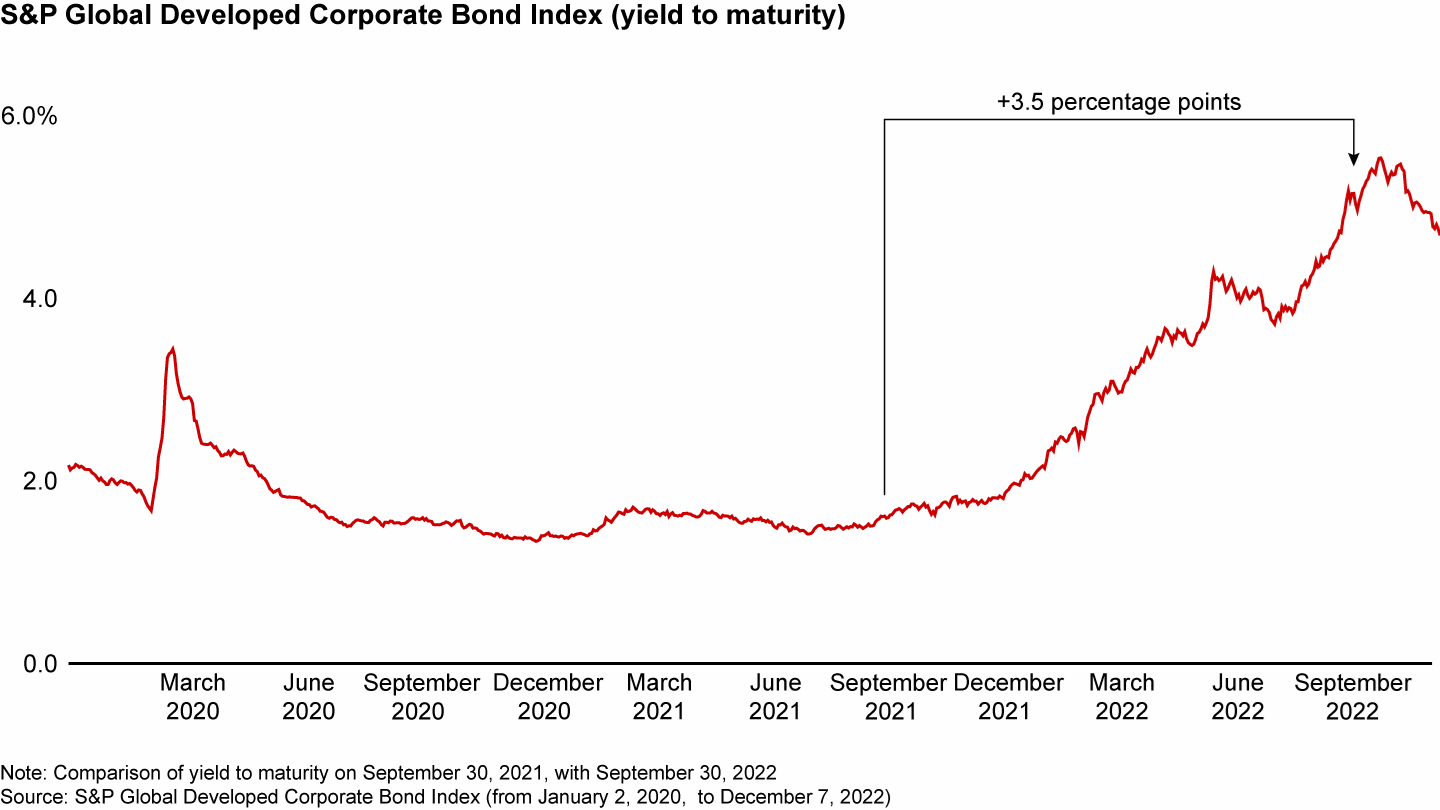
Digital infrastructure deals will continue despite the rising cost of debt. That activity is propped up by the available dry powder of longer-term investors, strong underlying demand trends, government support, and the many high-quality tower and fiber assets that are still expected to come to market. Tower deals performed particularly well during the last half of 2022 despite the higher cost of debt. High digital infrastructure investor demand will create a wave of particular interest in data centers.
The technology-enabled “great delayering” of the telecom business model into infrastructure, services, platform, and vertical businesses will further inspire M&A activity. A final impetus behind deals: Private investments will maintain momentum for as long as private telco valuations stay significantly higher than public telco valuations. In particular, listed challenger telcos and listed telcos with large controlling shareholders are expected to see further public-to-private bids and de-listings.
Five basic questions for telecom players in 2023
In 2023 and beyond, telcos (as well as their investors) need to develop new strategies and capabilities to take advantage of these M&A opportunities, chances to partner, and possibilities to divest or invest in selected portfolio assets. For many, the decision about when, where, and how to participate will come down to answering their respective versions of these five fundamental questions:
- What market consolidation options are left, and how can they be achieved via M&A?
- Can we be front-runners for fiber, tower, and data center rollup and consolidation?
- Which challenger telcos will be most impacted by inflation and the rising cost of debt, and how will that impact M&A action?
- With the great delayering of the telecom business model underway, can infrastructure assets such as edge data centers and mobile Internet companies still be created?
- Where are the undervalued, listed telco assets that could create more value as a private company?
The authors would like to thank Clara Kessler and Marlene Kessler for their contributions to this chapter.